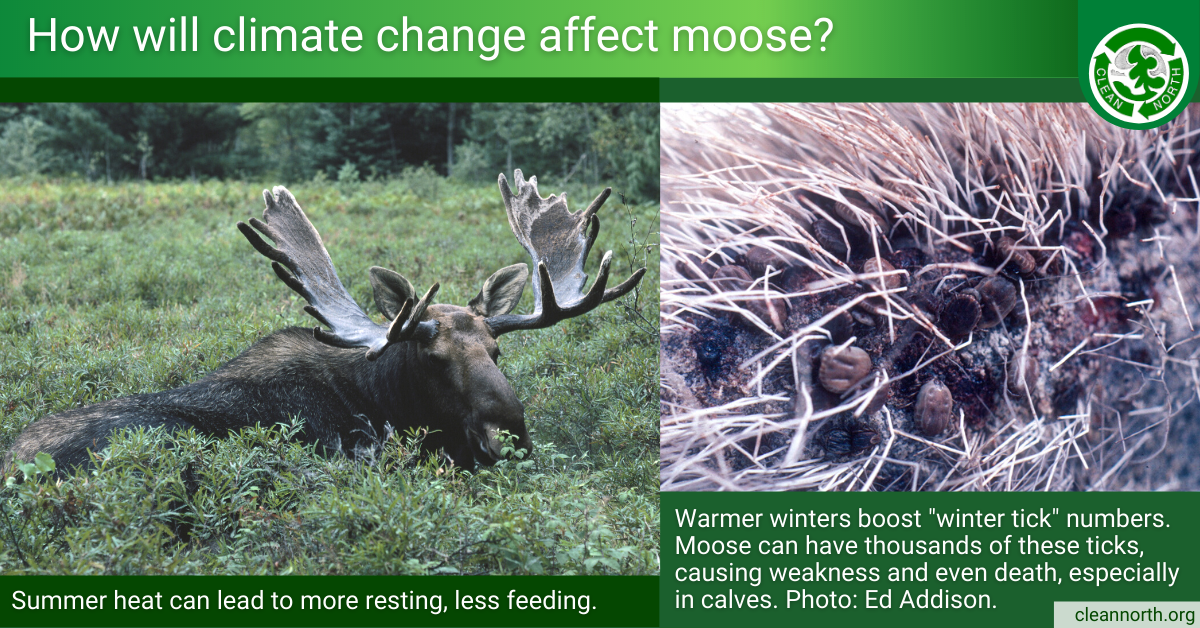
If we had to pick one wildlife species that best represents the glory of the Northern Ontario wilderness, it would probably be moose. This majestic animal is a key player in northern ecosystems, provides us with food, is vital to First Nations people, and helps draw tourists to our neck of the woods. While North America overall has a lot of moose (close to 1 million!), moose populations in some places are declining steeply. And climate change is giving a leg up to some of the key causes, which could begin to affect our local moose more and more in the coming decades.
Habitat loss/changes
As the climate is changing, so are our forests. By the end of this century, Sault. Ste. Marie could have a climate more like Windsor’s. The amount and quality of habitat that moose prefer could drop sharply. Without the right habitat, moose populations could plummet.
Heat stress
Moose love the cold! With milder winters and hotter summers, they are already feeling the heat. Warmer fall temperatures can delay moose breeding, with calves born later in the spring. These calves may then go into their first winter underweight with less chance of survival. And heat-stressed moose tend to seek shade and rest rather than forage. Eating less can lead to problems like weight loss, reduced ability to fight off diseases and pests, and reduced fertility/fewer calves.
Winter tick
Shorter, milder winters, especially higher temperatures in late winter, are allowing a tiny critter known as the winter tick to become more common and live through the winter in larger numbers. This tick stresses moose more than other deer species. Individual moose have been found with 70,000 or more such ticks on them! These pests can remove so much blood that moose die of exhaustion. Studies in New England have found that in some locations, close to 90% of moose calves are dying due to blood loss from winter ticks. The ticks can also drive moose to lick themselves or rub against trees until their fur comes off and their skin is raw. These large bare, raw patches leave moose more vulnerable to cold and infections.
Competition from deer
Warmer temperatures and reduced snowpack favour white-tailed deer over moose. As a result, deer are expanding their range in northern Ontario. With more deer comes increased risk of diseases and pests spreading from deer to moose (not just winter tick but also meningeal brainworm and liver fluke).
So…things look a bit worrying for one of our keystone Northern Ontario species. What can we do?
- Educate yourself about the expected impacts of climate change on Northern Ontario wildlife.
- If you are out in the bush and can safely photograph moose with signs of winter tick, upload photos to the iNaturalist Winter Tick Observation Network page at https://inaturalist.ca/projects/winter-tick-observation-network-e2b5a246-9899-43bc-979f-f03b71f5fdb0.
- Speak up. Contact your elected officials at all levels of government to ask how they plan to protect moose and other wildlife. Hold our elected leaders accountable for failing to act on climate change.
- Learn how you can reduce your family’s carbon footprint, especially through reducing energy consumption and reducing waste.
Read more
- https://www.wbur.org/news/2022/05/18/moose-tick-deaths-climate-change
- https://thenarwhal.ca/ghost-moose-drone-search-for-a-winter-tick-cure/
- https://www.youtube.com/watch?v=SUy5JQKqKTg
- https://ontarionature.org/news-release/does-this-moose-stand-a-chance/
- https://www.cbc.ca/news/canada/new-brunswick/winter-ticks-climate-change-moose-1.5452694
- https://www.rcinet.ca/en/2020/02/06/study-finds-life-threatening-numbers-of-ticks-on-moose/
- https://ottawacitizen.com/news/local-news/blood-sucking-ticks-threat-to-moose
- https://wildlife.onlinelibrary.wiley.com/doi/10.1002/jwmg.21649




